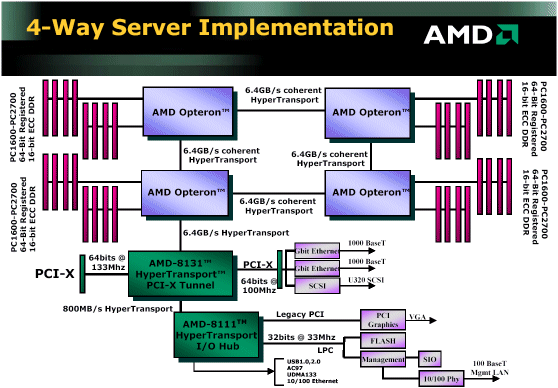INTEL Bensley (Dempsey + Blackford) copies Athlon MP
INQ had this insightful article which compared the architecture of the next generation INTEL Bensley Platform based on the Blackford chipset with the 1998 Alpha EV6. You can see from the block diagram, basically, INTEL Bensley/Dempsey/Blackford architecture will be identical to Alpha EV6, with a chipset which has two independent buses.
We know DEC Alpha folks have been working at AMD, Dirk Meyer, an Alpha architect, is now AMD's COO and head of the CPU business. Alpha's lead architect is also at AMD. So it should not be surprising that AMD used this same EV6 architecture prior to Opteron (Opteron is pretty much Alpha EV7 for x86).
Indeed, look at the Athlon MP's block diagram (scroll down to the bottom of the linked page, you will see the diagrams) at acehardware.com and compare it to Xeon MP and Bensley platform, you see Athlon MP had pretty much the same architecture as Alpha EV6.
The 2001 Athlon MP had the dual FSB architecture. And that will be INTEL's next generation Bensley/Dempsey/Blackford.
Left: Xeon with shared FSB; Right: the Athlon MP with dual FSB
Acehardware.com wrote back in 2001:
"The AMD-760MP chipset has two 2.1 GB/s connections, one to each processor. In other words, the equivalent of a 4.2 GB/s shared bus. The two processors of a Dual Pentium III Xeon must share a 1.066 GB/s bus, while the two Pentium 4 Xeons have to share a 3.2 GB/s bus. "
As we can see from this benchmark, the discontinued Athlon MP 2GHZ/512KB cache was quite competitive against Xeons (3GHZ) and low end Opterons (1.6GHZ). AMD discontinued Athlon MP because Direct Connect Architecture is much much better.
The conclusion is unequivocally this: INTEL's Bensley platform based on the Blackford chipset is no more than an imitation of Athlon MP, which in turn was based on Alpha EV6. Athlon MP was for 2P servers, the Bensley/Dempsey/Blackford will also be 2P only, so both Athlon MP and Bensley are in for the same market. We should also notice that IBM's Hurricane chipset is also similar to the discontinued AMD-760MP, but with ports for scaling up.
In other words, INTEL's 2006 Bensley platform will be basically the same as 1998's technology by design, with dual FSBs. Of course, the Bensley platform improved on Athlon MP by having higher frequencies on the CPU and the buses.
And, we know that INTEL's Merom will be a Pentium III (1999) with some Pentium IV charateristics added.
The AMD64 (Opteron, Athlon64, Turion 64, Sempron 64) architecture shines because it has embedded memory controllers to reduce latency and 1GHZ HyperTransport links for I/O and communications between CPUs. There is no FSB in AMD64. Opteron can scale linearly up to 8P SMP without any chipset, this is called glueless 8 way SMP. The next generation of Opteron can scale to 32P glueless SMP.
Below is a diagram for Opteron published on vanshardware.com in 2002, as you can see the four opterons were connected to each other directly (gluelessly) with 800MHZ cHTT links (new HTTs are 1GHZ), each Opteron has its own memory, there was no NB chipset involved--remember the year, it was 2002. 2006 Bensley copies 2001 Athlon MP, 5 years behind on that, and we won't see something similar to Opteron from INTEL until 2009.


0 Comments:
Post a Comment
<< Home